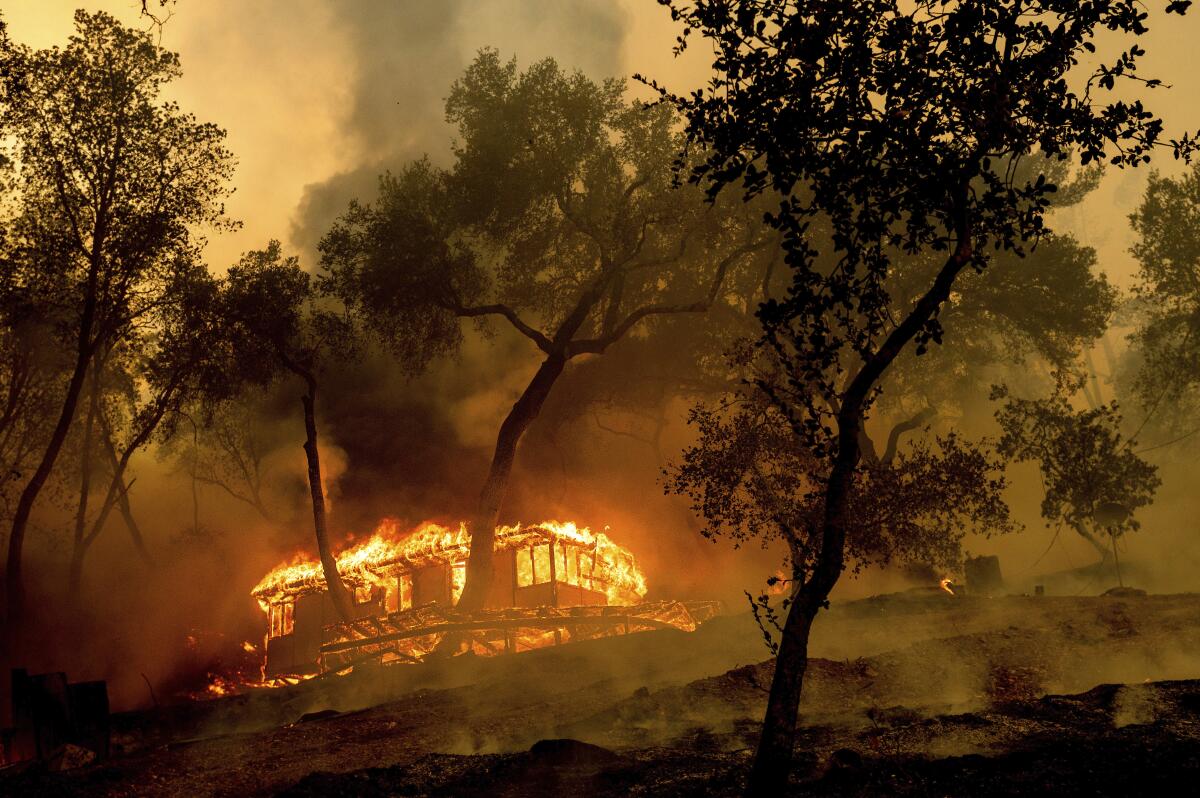California firefighting resources ‘stretched’ by 23 major wildfires, Newsom says

- Share via
SACRAMENTO — Gov. Gavin Newsom said Wednesday that resources to fight wildfires are “stretched” as more than 23 major fires scorch California, burning homes, forcing evacuations and raining ash across the northern part of the state.
Governors in Nevada, Arizona and Texas have agreed to send engines or crews to support California, but the call for mutual aid from other states is complicated by a historic heat wave across the West, Newsom said. The high temperatures have strained the state’s energy grid and resulted in power outages for hundreds of thousands of residents.
“We are challenged right now by the number of new fires all over the state of California,” the governor said during a midday briefing. “We’ve put out every resource we have.”
The combination of wildfires, outages and the worst health crisis in a century has ramped up the pressure on the Newsom administration, which has dealt with one disaster after another since he took office in 2019. California is on track to hit as many as 700,000 coronavirus cases over the next few weeks, and the threat of the virus is requiring the state to reconfigure emergency evacuation centers and fire camps to lessen the risk of spread.
The governor said more than 10,800 lightning strikes have hit the state in the last 72 hours in what has become an acute wildfire season. Newsom said California has experienced 6,754 fires to date this year, compared with around 4,000 at this point in 2019.
“The total number of fires last year was substantially lower than the activity we’re experiencing this year, and what has occurred over the last 72 hours has certainly stretched the resources of this state,” Newsom said.
As wildfires grew in number and intensity in recent years, the state’s system of fire departments sending equipment and personnel to blazes in neighboring communities has come under stress. Some departments are reluctant to draw down resources they might need to fight fires within their own jurisdictions.
In declaring a state of emergency Tuesday, Newsom wrote that the number of fires burning in Western states “has resulted in a strain on California’s mutual aid system, making it increasingly difficult for jurisdictions to obtain the necessary in-state and out-of-state firefighting resources to respond to these fires.” The emergency declaration also mobilized the California National Guard to support disaster response.
At the same time, the California Department of Forestry and Fire Protection has seen a substantial reduction in available inmate firefighters because of early release, parole and coronavirus quarantines. Nick Schuler, a deputy chief with Cal Fire, said 90 of the 192 funded hand crews were available to fight fires as of Friday.
The state’s decision to release minimum-security prisoners in light of the pandemic added to the decline. State officials invested $72.4 million in emergency funds to hire 858 firefighters and six California Conservation Corps crews to bolster the force. The governor said Wednesday that 830 of those seasonal positions have been filled.
To help fill funding gaps, the Newsom administration secured grants over the last week from the Federal Emergency Management Agency to help fight blazes in Monterey, Napa and Nevada counties. The governor’s office said the grants allow local, state and tribal governments to receive reimbursement for up to 75% of certain firefighting costs.
Cal Fire said Wednesday that the state had requested 375 engines from other states and called up every available private helicopter licensed to respond to federal and state incidents. Schuler described California as well-prepared but said the amount of fires had nearly exhausted all resources.
“There are moments in time where the fire activity is so significant that no matter how much you prepare, the system will be overwhelmed,” Schuler said.
The Hennessey fire, one of largest blazes within a group of fires in Napa, Sonoma and Solano counties, approached Vacaville overnight and prompted urgent evacuations of residents on the town’s western border, according to Cal Fire. As of Wednesday evening, the so-called LNU Lightning Complex had spread to more than 46,000 acres with zero containment. Cal Fire officials said the fleet of available air tankers was stretched thin because of multiple fires in the region.
A cluster of fires in Santa Clara, Alameda, Contra Costa, Stanislaus and San Joaquin counties known as the SCU Lightning Complex totaled more than 85,000 acres and was only 5% contained late Wednesday. The state deployed more than 500 personnel, 25 fire engines, three helicopters, three water tenders, 17 hand crews and nine bulldozers to the fire.
The threat of more fires remains high, with a large swath of the state from the Central Valley to northeastern California under red flag warnings. Additional power outages loomed Wednesday as temperatures remained high.
Newsom signed an emergency proclamation Monday in hopes of ensuring backup energy will be available to alleviate pressure on the state’s electricity grid. State government buildings closed early while the governor urged industrial, commercial and residential customers to limit their energy use.
The governor said he accepts ultimate responsibility for the power outages while ordering an investigation and promising to get to the bottom of what happened.
“To make this crystal clear, we failed to predict and plan for these shortages and that’s simply unacceptable,” Newsom said Monday. “I’m the governor, I’m ultimately accountable and ultimately take responsibility … to immediately address this issue and move forward and make sure this simply never happens again here in the state of California.”
The governor renewed a call for Californians to reduce their energy consumption from 2 p.m. to 9 p.m. Wednesday.
More to Read
Sign up for Essential California
The most important California stories and recommendations in your inbox every morning.
You may occasionally receive promotional content from the Los Angeles Times.











